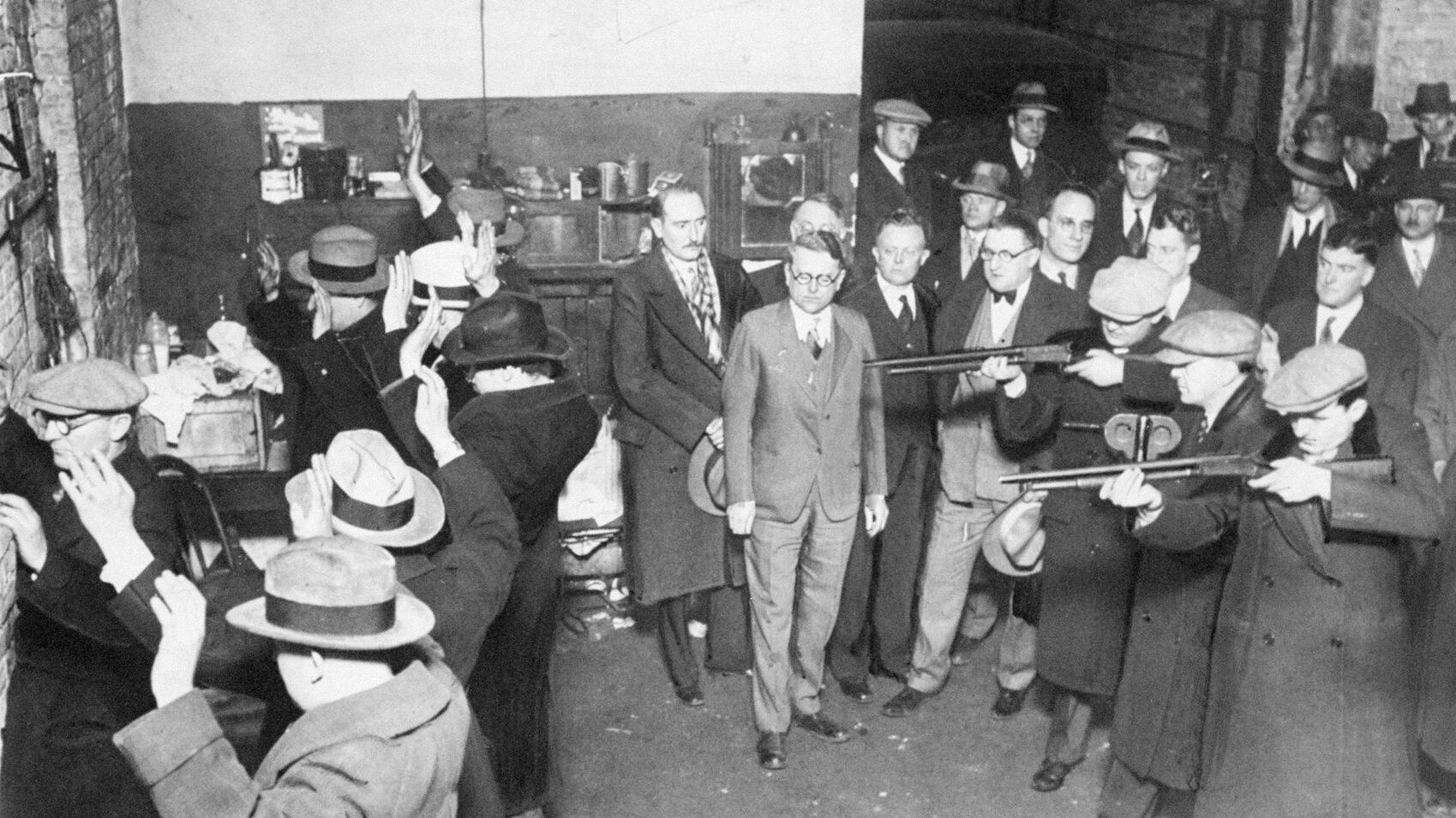
What happened on February 14, 1929, in Chicago? On this day, the infamous St. Valentine's Day Massacre took place, forever marking a dark chapter in American history. Seven members of the North Side Gang were brutally murdered in a garage at 2122 North Clark Street. The assailants, disguised as police officers, used Thompson submachine guns and shotguns to carry out the attack. This violent event highlighted the intense gang warfare of the Prohibition era, with Al Capone often suspected but never officially linked to the crime. The massacre shocked the nation, showcasing the brutal reality of organized crime in Chicago.
Key Takeaways:
- The St. Valentine's Day Massacre, a brutal event during the Prohibition era, highlighted the violent gang warfare in Chicago and led to the eventual downfall of Al Capone.
- Despite its cultural significance, the St. Valentine's Day Massacre serves as a reminder of the violent history of organized crime in America and the need for effective law enforcement to prevent such tragedies.
35 Facts About the St. Valentine's Day Massacre
The St. Valentine's Day Massacre is one of the most notorious events in American history. Taking place during the Prohibition era, it highlighted the brutal gang warfare that plagued Chicago. Here are 35 detailed facts about this tragic event.
The Event
The massacre itself was a shocking display of violence that left a lasting impact on the city and the nation.
- Date and Time: The massacre occurred on February 14, 1929, at 10:30 AM CST.
- Location: It took place at the S.M.C. Cartage Company garage, located at 2122 North Clark Street in Lincoln Park, Chicago, Illinois.
- Victims: Seven members and associates of the North Side Gang were killed. The victims included Peter Gusenberg, Frank Gusenberg, Albert Weinshank, Adam Heyer, Reinhardt Schwimmer, John May, and James Clark.
- Assailants: The perpetrators were four unknown men, two of whom were disguised as police officers. Their identities were never confirmed.
- Weapons: The assailants used two Thompson submachine guns and two shotguns to carry out the massacre.
- Method of Attack: The victims were lined up against a wall and shot repeatedly, even after they were down.
The Scene
The setting and conditions of the massacre added to the horror of the event.
- Weather Conditions: On the day of the massacre, it was a typical winter day with light snow and a temperature of 18 degrees Fahrenheit.
- Disguise: The perpetrators dressed as police officers to gain the trust of the victims, making it easier to carry out the attack.
- Garage Description: The garage where the massacre took place is now marked by a fence and a large tree where the building once stood.
The Aftermath
The immediate aftermath of the massacre revealed the brutality of the attack and the challenges faced by law enforcement.
- Frank Gusenberg's Survival: Frank Gusenberg was mortally wounded but survived for three hours after the attack. He died at a local hospital, refusing to cooperate with the police and stating, "Nobody shot me".
- John May's Medal: One of the victims, John May, always carried a Saint medal in his back pocket. During the massacre, the medal was hit by a bullet, but May was finished off with a shotgun to ensure no survivors.
Key Figures
Several key figures were linked to the massacre, either as suspects or victims.
- Al Capone's Involvement: Although Al Capone was generally suspected of orchestrating the massacre, he was in Florida at the time and never officially linked to the crime. However, his rivalry with George "Bugs" Moran and the North Side Gang was well-documented.
- Capone's Florida Residence: During the time of the massacre, Al Capone was staying on Palm Island, Florida.
- Jack McGurn’s Alibi: Jack McGurn, a suspected participant in the massacre, had an alibi provided by his girlfriend, who claimed they were together in bed until 1:00 PM that afternoon.
Law Enforcement
The massacre highlighted the corruption and challenges faced by law enforcement during this period.
- The Untouchables: The Untouchables, a special squad of agents led by Eliot Ness, eventually brought down Al Capone not for his violent crimes but for tax evasion. Capone was sentenced to 11 years in jail, fined $50,000, and charged $215,000 (plus interest) due on back taxes on November 24, 1931.
- Chicago's Corruption: During the 1920s and early 1930s, Chicago was considered the most corrupt city in the United States. This corruption extended to law enforcement and politics, making it difficult to solve crimes like the St. Valentine's Day Massacre.
Impact on the North Side Gang
The massacre had a significant impact on the North Side Gang, weakening its power and influence.
- Impact on the North Side Gang: The St. Valentine's Day Massacre significantly weakened the North Side Gang. Although it continued to exist, its power and influence were greatly diminished.
Public Reaction
The public's reaction to the massacre was one of horror and outrage, leading to increased concern for public safety.
- Public Reaction: The massacre prompted an outcry from citizens and greater concern from all levels of law enforcement. However, despite numerous investigations and suspects, no one was ever convicted of the crime.
- Symbolic Date: Some speculate that the date of the massacre was chosen symbolically, as it coincided with Valentine's Day. However, it is more likely that the date was selected ahead of time due to the escalating gang warfare between Capone and Moran.
Historical Context
Understanding the historical context of the Prohibition era helps explain the environment in which the massacre occurred.
- Historical Context: The Prohibition era and the rise of organized crime in Chicago created a volatile environment where gang warfare was common. The St. Valentine's Day Massacre was just one of many violent incidents during this period.
Media and Pop Culture
The massacre received extensive media coverage and has been referenced in numerous films and books.
- Media Coverage: The St. Valentine's Day Massacre received extensive media coverage, making Al Capone a nationwide celebrity. His photo even appeared on the cover of Time Magazine on March 24, 1930.
- Pop Culture References: The St. Valentine's Day Massacre has been referenced in numerous films, including "Scarface" (1932) and "The Untouchables" (1987). These adaptations have kept the event in the public consciousness, even though the actual perpetrators remain unknown.
Research and Similar Incidents
Researching the event using primary sources and comparing it to similar incidents provides a deeper understanding of its significance.
- Primary Sources: Researching the event using primary sources like The Times Digital Archive and Daily Mail Historical Archive provides a more detailed understanding of the massacre and its historical context.
- Similar Incidents: There have been other incidents similar to the St. Valentine's Day Massacre throughout history. For example, in 1968, a shooting in London involving scrap-metal merchants was compared to the Chicago massacre, and in 1978, three workmen were killed in an argument in a shed.
Modern-Day Incidents
Even decades later, similar incidents have occurred, highlighting the ongoing issue of gun violence.
- Modern-Day Incidents: Even 80 years after the original massacre, similar incidents have occurred. In 2008, a shooting at Illinois University resulted in five deaths and 13 injuries before the shooter took his own life.
Historical Significance
The massacre marked a turning point in the Prohibition era and highlighted the need for stricter law enforcement.
- Historical Significance: The St. Valentine's Day Massacre is significant not only because of its brutality but also because it marked a turning point in the Prohibition era. It highlighted the need for stricter law enforcement and the eventual downfall of Al Capone.
Investigations
Various investigations and re-enactments have been conducted to understand the dynamics of the massacre.
- Gale Primary Sources: Using Gale Primary Sources provides access to a wealth of historical information, including names of real people, historical images, and related incidents. This resource helps in understanding the true history behind the massacre.
- Chicago Police Re-enactment: The Chicago Police re-enacted the scene to understand the dynamics of the murder. This re-enactment was an attempt to recreate the events and possibly identify the perpetrators.
- Fred Burke’s Involvement: One of the assailants was identified as Fred Burke, whose guns were found in his home. This identification was part of the ongoing investigation into the massacre.
Public Reaction at the Time
The public's reaction to the massacre was one of horror and outrage, leading to increased concern for public safety.
- Public Reaction at the Time: The public reaction to the massacre was one of horror and outrage. The event was widely covered in newspapers, and it sparked a greater concern for public safety and law enforcement.
Al Capone’s Downfall
Although not directly linked to the massacre, Al Capone's eventual downfall came from tax evasion charges.
- Al Capone’s Downfall: Although Al Capone was not directly linked to the St. Valentine's Day Massacre, his eventual downfall came from tax evasion charges. The Untouchables, led by Eliot Ness, played a crucial role in his conviction and imprisonment.
Legacy of the Massacre
The massacre has left a lasting legacy in popular culture and serves as a reminder of the violent history of organized crime in America.
- Legacy of the Massacre: The St. Valentine's Day Massacre has left a lasting legacy in popular culture. It has been referenced in numerous films, books, and documentaries, ensuring that the event remains in the public consciousness.
- Historical Accuracy: Despite its cultural significance, the historical accuracy of the St. Valentine's Day Massacre is often overshadowed by its dramatic portrayal in media. Researching the event using primary sources helps in understanding the true events and their context.
- Symbolic Meaning: The St. Valentine's Day Massacre has taken on a symbolic meaning over time. It represents the darker side of human nature and the consequences of gang warfare during the Prohibition era.
- Continued Interest: The St. Valentine's Day Massacre continues to fascinate people due to its brutality and the mystery surrounding its perpetrators. It serves as a reminder of the violent history of organized crime in America and the need for effective law enforcement to prevent such tragedies.
The Enduring Mystery of the St. Valentine's Day Massacre
The St. Valentine's Day Massacre remains one of America's most notorious unsolved crimes. On February 14, 1929, seven members of the North Side Gang were brutally gunned down in a Chicago garage. The killers, disguised as police officers, used Thompson submachine guns and shotguns to execute their victims. Despite extensive investigations, the identities of the assailants were never confirmed. Al Capone, often suspected of orchestrating the attack, was never officially linked to the crime. This event highlighted the violent gang warfare of the Prohibition era and the rampant corruption in Chicago. The massacre weakened the North Side Gang and increased public outcry for stronger law enforcement. Even today, the St. Valentine's Day Massacre fascinates people, serving as a grim reminder of the dark history of organized crime in America.
Frequently Asked Questions
Was this page helpful?
Our commitment to delivering trustworthy and engaging content is at the heart of what we do. Each fact on our site is contributed by real users like you, bringing a wealth of diverse insights and information. To ensure the highest standards of accuracy and reliability, our dedicated editors meticulously review each submission. This process guarantees that the facts we share are not only fascinating but also credible. Trust in our commitment to quality and authenticity as you explore and learn with us.


